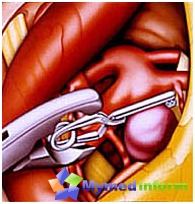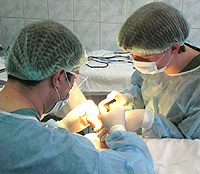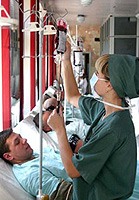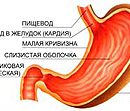Aneurysm is the defeat of the artery plot in the form of limited thinning and expansion or in the form of a protrusion emanating from the wall of the artery.
Content
Surgical treatment aneurysm
Under surgical treatment, the aortic aneurysms is understood as the excision of it and the replacement of the remote (aneurysmatic) section of the aorta synthetic prosthesis. Anneurysm is called a special shattered expansion of the wall of the aorta department, which arises due to thinning its wall. This happens when the aortic walls are amazed by any inflammatory process or atherosclerosis.
 Aneurysm – This is a serious problem, as it increases with the increase in its growth and the risk of its very terrible complication – Ripple. In addition to this complication, with aortic aneurysm, such a phenomenon is also found as the formation of blood clots and enhancing them in various organs and tissues, where the vessel blocking occurs. Fortunately, aneurysms are treatable. There are several methods for the treatment of aortic aneurysms, so that if one method does not fit you, it is quite possible, another. These are methods such as an open method (or surgical) and endovascular (stenting method). The choice of the method of treatment of aneurysm depends on many factors, such as the size, localization and form of aneurysm, as well as the general condition of the patient.
Aneurysm – This is a serious problem, as it increases with the increase in its growth and the risk of its very terrible complication – Ripple. In addition to this complication, with aortic aneurysm, such a phenomenon is also found as the formation of blood clots and enhancing them in various organs and tissues, where the vessel blocking occurs. Fortunately, aneurysms are treatable. There are several methods for the treatment of aortic aneurysms, so that if one method does not fit you, it is quite possible, another. These are methods such as an open method (or surgical) and endovascular (stenting method). The choice of the method of treatment of aneurysm depends on many factors, such as the size, localization and form of aneurysm, as well as the general condition of the patient.
Aneurysm can be located in the arteries of any caliber, but most often they are found in Aorte. Depending on the aortic department, where the aneurysm is located, it is called an aneurysm of the abdominal degree of aorta or the thoracic aorta. In addition, aneurysms can be located in hip arteries, knee, spleen, liver, kidney or stomach. But the most common type of aneurysm – This is an aneurysm of the abdominal department of aorta.
Not all aneurysms require immediate treatment. If aneurysta has small sizes, the doctor can offer expectant tactics.
When aneurysta reaches life-focused sizes, the doctor may offer you surgical treatment. Operation on the aneurysm is carried out under the anesthesia. As mentioned, treatment can be supposed to either in replacing the affected area of the aorta with a prosthesis, or in the installation of the stent. Stent – This is a wire cylindrical design that serves as a frame for a plot of artery. Sometimes an emergency operation is the so-called complaint, that is, when aneuryzima, discovering as a bag with one of the sides of the aorta, is clarified by its base with a special clip.
Preparation for operation for aortic aneurysm
Before the operation, the doctor usually collects all the necessary data on the patient's disease. This is his complaints when they arise, for how time they are bothering the patient. In addition, the doctor conducts a survey, which is to carefully feel the place of the aneurysm and auditioning with the help of the phoneneoscope. Be sure to carry out additional research methods, such as:
- Ultrasonic scanning
- CT scan
- magnetic resonance angiography
- angiography
Before the operation, the doctor will recommend you not have for 8 hours. Also, if you take any medicines, you need to discuss with the surgeon about their further reception before and after the operation.
The need for the treatment of aortic aneurysm
Treatment about aortic aneurysm can be both planned and emergency, according to life indications. Planned treatment is carried out when the aortic aneurysm reaches certain sizes, depending on the location of the aneurysm, or if it is growing rapidly. Less often, planned treatment aneurysm must be provided that it breaks blood flow in the legs.
Emergency treatment of aortic aneurysms is required during life-gauge states, for example, in the threat of its gap or bundle, or with a tearing break. Also emergency treatment can be carried out in the occurrence of severe pain in the stomach or in the back, which indicates the stratification of the aneurysm.
Risk during operation about aortic aneurysm
Serious health problems that are particularly often found in the elderly patients can increase the risk of complications during an operation about aortic aneurysm. In the absence of concomitant diseases, the elderly age of the patient is not a contraindication to the operation. The risk of complications during surgery is increased with the following concomitant diseases:
- Stagnant heart failure
- diabetes
- Chronic obstructive lung diseases when there are violations of pulmonary ventilation
- angina
The doctor must estimate the presence of these risk factors before the operation.
Operation for aortic aneurysm
Usually, the operation is carried out under general anesthesia (a state at which on the background of losing or preserving consciousness is partially or completely lost sensations, and therefore there is no pain). Depending on the localization of the aneurysm (aorta, the knee artery and t.D.) cut can be in the abdomen, limb or other area.
As soon as the surgeon reaches the aneurysm space, it presses the upper section of the artery or aortic, so that the blood does not go into aneurysm. So, the surgeon can either remove the changed aorta section and replace it with a synthetic prosthesis, or to enter the aneurysm in the aneurysm, or exchem.
In some cases, when aneurysm is located in the area of small arteries, for example, in the arteries of the leg, the surgeon can delete the artery section and replace it with a region of Vienna.
Less likely when the surgeon cannot clip up aneurysm due to its location, the so-called sealing seal is performed using a metal or plastic. This type of operation will be caused by the catheter introduced into the vessel. The seal fills the aurosexis lumen and prevents its filling it with blood.
After surgery, the patient needs a rehabilitation period for a period of 7 to 10 days.
Complications after surgery about aortic aneurysm
As after any surgical interventions, after surgery for aortic aneurysm may be complications. They include:
- heart complications
- Completions from the lungs
- kidney complications
- intestinal complications
In addition, there may be infectious complications from the operating room, urinary tract infection and lungs. It is very rarely due to the distribution of blood thrombus vessels from the operation site, there may be strokes (violation of the blood circulation of the brain) and paralysis (complete loss of the motor function). Also, there is such a complication as retrograde ejaculation (in men), when the sperm on the seed duct goes back to seed bubbles. It is worth noting that all these complications are connected mainly with emergency interventions for aneurysm.
Prevention of aneurysm
To achieve maximum results after an operation about aortic aneurysm, you should change the usual way of life. First of all, it is necessary to achieve normalization of blood pressure and cholesterol in the blood, as they are the main risk factors aneurysm. Events aimed at this:
- Low cholesterol food intake
- Exercise exercise
- to give up smoking
- Normalization of body weight









